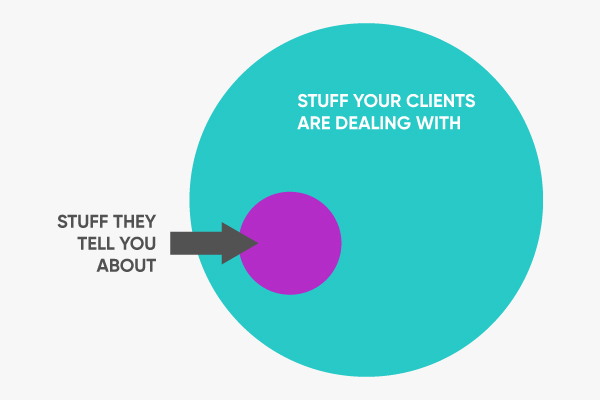Understanding Client Behavior
You can now enjoy our content in audio format!
It’s not always easy to understand what your clients are up to. Obviously being a good listener and asking the right questions will help you wrap your head around client behavior. But even then, there’s almost assuredly a big gap between the stuff they are dealing with and what they are talking to you about.
This gap is where misunderstandings come from.

Why Clients Churn
In client behavior, it’s the misunderstandings that matter the most. The majority of clients are likely to be satisfied quietly. Then you have some that are likely to be evangelists. Those clients are awesome, because they drive referrals. If we look back at the virtuous cycle, creating positive client experiences leads to referrals, and that’s what drives your business forward.
But there’s also a percentage of your clients who might be at risk for a negative experience, and if they experience one, could be detrimental to your business. That means churn, or worse yet, negative reviews. Let’s focus there, on the assumption that you already have it within your power to create exceptional experiences for your customers.
The top reasons for churn, with some studies coming in around 2/3 of all churn, is bad customer experiences. These are also the most likely to tell others about their negative experiences. In the MSP world, this doesn’t necessarily mean being able to easily solve every ticket; it means that the service experience itself was high quality. How fast you respond to a ticket is more important than how fast it takes you to resolve the issue.
Another big reason for churn is that you’re not providing enough value. That can be addressed in a couple of ways. First, make sure your salespeople aren’t making promises that your service team can’t deliver. Second, make sure your clients understand your value. It’s that whole thing of “Everything is working, so why am I paying you?” Make sure your clients are fully aware that “everything is working” is not a default state, but a state you worked hard to achieve.
Note that communication is important in reducing churn. In fact, poor communication is an often-cited reason for churn. This isn’t just picking up the phone quickly, either. It’s making sure that you don’t make a lot of mistakes, and when you do you take ownership of them, and walk your client through the situation and the different resolution options calmly and carefully. If you come in saying “here’s how it’s going to be” they won’t be happy, but if you do nothing, you won’t be happy.
The good news is that while lousy communication is a massive turn off for a client in such situations, great communication can actually improve loyalty and create a new evangelist. This is because clients are people, too. They recognize that mistakes happen, and it’s all about how those mistakes are handled.
Case Study
Let’s say you just noticed that a client had added ten new employees a few months ago, but for some reason, you weren’t billing the client for these extra seats. That money makes a difference to you, no question, because you’re a little tight coming into payroll time and you want to get paid for the work you’ve done. But the error was on your end.
How you handle this situation reflects the client’s perception of their experience with you. You’ll need effective communication, creativity in coming up with a solution, and dedication to providing the best service possible.
The more you understand what specifically triggers a client to think “bad experience”, the better you’ll be at avoiding churn. You can access our discussion about client triggers here.
To stay up to date with the latest from Gradient, subscribe below.
Let's take the hassle out of reconciling your vendor usage each month.
Want to learn more how Gradient ensures yours PSA contracts always reflect accurate vendor counts for monthly billing?
Book a meeting